Portfolio of Doll Garments
by Lisha Vidler
1870s Combinations (Original Design ~ Sewn in August 2013)
Designed for the 15.5″ Gene Marshall doll, this is a simple Victorian undergarment that combines a chemise and drawers in one. While the design is not wholly authentic, it was inspired by fashion plates of 19th century undergarments.
Features
This garment is made of semi-sheer white voile. It fastens with tiny 5/0 snaps, but has a row of non-functional 3mm shank buttons down the front. Because it’s sleeveless, the armscyes are faced with self-bias binding, as is the neckline. It’s darted for shaping and all the raw edges are finished with mock-French seams. The legs are embellished with narrow pintucks and gathered heirloom lace.
Things I Learned the Hard Way. . . .
- Little details make a big difference, like using tiny pintucks and lace edging on the legs.
- “Historically accurate” doesn’t necessarily mean “better.” I went through several more accurate mockups before I figured out I needed to streamline the pattern to better suit the doll.
- When working with sheer fabrics, remember that the inside of the garment must be as neat as the outside—it will show.
- If you’re going to finish curved seams, you need to avoid clipping or notching them. My mock-French seams didn’t turn out as well as I’d hoped because I’d already clipped the seam allowance.
1560s Undergarments (Original Design ~ Sewn in May 2013)
Made for the 16″ Tyler Wentworth doll, this is a set of mostly authentic undergarments from the 1560s. Included is a shift, drawers, underskirt, and stockings.
Features
The shift is made of white voile. It’s loose-fitting and long-sleeved, with a faced neckline. The drawers are also made of white voile, but are embellished with a fine black lace, intended to simulate blackwork, a common form of 16th century embroidery. They tie at the waist with a silk ribbon.
The underskirt is made of a dark red mystery fabric from my stash. It’s gathered to a waistband and fastens with a side placket. The hem is bound with a guard, an authentic technique used to prevent wear on the more expensive skirt fabric. In this case, however, the guard is made of the same material.
The stockings are made of ivory tissue knit. Surprisingly, they are snug enough to stay up on their own, although historically, they would have been worn with tied garters.
Things I Learned the Hard Way. . . .
-
Using a really stretchy fabric for stockings means they’ll stay up without garters!
-
Historic patterns can often be modified to work for dolls.
-
Shortcuts can be awesome. For example, using delicate black lace instead of hand embroidering the blackwork on the drawers.
-
Sometimes, doing things the historic way isn’t appropriate for dolls. Gathering the skirt to the waistband produced way too much bulk.
Empire Ballgown (Original Design ~ Sewn in May 2013)
Designed for the 15.5″ Gene Marshall doll, this is an original ballgown with a matching petticoat and shawl.
Features
This ballgown is made of an extremely lightweight copper-colored satin and lined with a high-quality tan lining fabric. It has an empire-waist bodice and a princess-seamed skirt, which gives it a snug fit through the torso before it flares out. Copper bugle beads and seed beads alternate to form the shoulder straps. The tulle shawl is edged with the same bugle beads. The skirt is supported by a tulle-ruffled petticoat.
Things I Learned the Hard Way. . . .
- It’s always great to try a new technique—especially if it works! This was the first time I’d sewn a baby hem and it was exactly the right technique for this style of skirt.
- Sometimes fabric doesn’t behave the way you want it to. When that happens, you can either quit and try with a different material or you can forge ahead and accept that it might not look exactly how you’d envisioned. (I didn’t care for the wrinkles that appeared on the finished bodice.)
- Don’t be afraid to adjust your pattern if something isn’t working. Raise the waistline, lower the hem, tweak the curves—whatever it takes to get a great-looking garment.
- You always need more tulle than you think when making ruffles.
Layered Evening Gown (Original Design ~ Sewn in October 2013)
Designed for Tonner’s 16″ Esme doll, this is an original two-piece layered evening gown with matching jewelery.
Features
This gown is made of an extremely lightweight satin, in both deep purple and a lavender-mauve, and is lined with a light tan fabric. The underdress is strapless, with a gathered empire-waist bodice and princess seams, so it fits snugly through the waist and flares into a full skirt. The one-shouldered overdress fits beneath the bust and hooks on the side, allowing the underdress to peek out. It’s accented with a miniature rhinestone buckle at the front-side closure.
The doll wears a matching necklace woven of tiny lavender and purple seed beads.
Things I Learned the Hard Way. . . .
-
Having scaled-down fabrics will make a huge difference in how the finished garment looks.
-
Matching jewelry isn’t difficult to make and can add the perfect touch to an evening gown.
-
Always check to make sure your pattern pieces aren’t backwards. I accidentally sewed the one-sleeved bodice mirror image of how it was supposed to be—oops!
The Phantom of the Opera in Miniature: “Point of No Return” (Designed by Maria Bjornson ~ Sewn in May 2012)
Made for the 15.5″ Gene Marshall doll, this is a recreation of a costume from Andrew Lloyd Webber’s musical production, The Phantom of the Opera. It’s meant to be a Victorian interpretation of an 18th century gown and therefore is not historically accurate for either era. Some have called it, “Rococo Steampunk.”
Features
The dress is made of a gold-shot taffeta, with a mock-underskirt of gold layered with black point d’esprit. The main skirt is covered with three rows of scalloped ruffles, trimmed with black Venetian lace. It’s supported by a tiered petticoat made of black broadcloth with tulle ruffles. The jacket-styled bodice has a ruffled lace-trimmed peplum to match the skirt. Its stomacher is embellished with embroidery and seed beads.
Things I Learned the Hard Way. . . .
- Ruffles are beautiful. Scalloped ruffles are even better.
- Fray Check is amazing for sealing raw edges that can’t be sewn, such as teeny-tiny scallops.
- Make sure your pattern is perfected before you cut your fabric. Don’t assume that you’ll be able to “work it out” on the finished garment. The result will be sloppy and amateurish.
- Be very careful to ensure that your darts are the same length and pointing in the same direction.
- When making an overlapping closure, trim it to the correct size before sewing it to a lining. Otherwise, you end up with a back closure that overlaps by an insane amount.
- There’s a reason most doll bodices are sewn with the sleeves being attached while the bodice is still open and flat. If you sew the side seams closed first, you’re left trying to insert a sleeve into an armseye that’s roughly the size of your index finger. Don’t do this! If you value your sanity, don’t do this!
The Phantom of the Opera in Miniature: Hannibal Ballet Costume (Designed by Maria Bjornson ~ Sewn in July 2013)
Made for the 15.5″ Gene Marshall doll, this is a recreation of a ballet costume from Andrew Lloyd Webber’s musical production, The Phantom of the Opera. It’s meant to be a Victorian interpretation of a Carthaginian slave dancer’s outfit.
Features
The color-blocked leotard is made of red and green satin. It’s fully lined and trimmed with gold braid and seed beads. The beaded straps are meant to dangle off the shoulders, while the breastplate is heavily embellished with gold braid, gold filigree medallions, and seed beads. The satin rope skirt attaches at the hips with a richly decorated gold belt.
The doll wears a custom-made tiara and cuff bracelets.
Things I Learned the Hard Way. . . .
- Mockups are vital for a well-made pattern. Without the umpteen trials I did of the fitted leotard, it never would have fit properly.
- They don’t make pointe shoes for this size doll. As a result, my ballerina is barefooted. (Edited to add: Tonner made a doll with ballet feet that can be swapped out for high-heel or flat feet. I used this doll to make another ballet costume from The Phantom of the Opera: the “Il Muto” mint green and pink outfit.)
The Phantom of the Opera in Miniature: Elissa’s “Think of Me” Skirt (Designed by Maria Bjornson ~ Sewn in June/July 2013)
Made for the 15.5″ Gene Marshall doll, this is a recreation of a costume from Andrew Lloyd Webber’s musical production, The Phantom of the Opera. During the first act, Christine is promoted from a chorus dancer to the lead soprano. When this happens, she removes her rope ballet skirt and replaces it with a heavily decorated full skirt. Therefore, this skirt is worn with the leotard from the above-mentioned Hannibal ballet costume.
Features
As previously described, the leotard is made of red and green satin. The green satin skirt is edged with a red satin ruffle, which is headed by a beaded metallic gold braid. A red satin and tulle petticoat gives the skirt its fullness. The overskirt has a false peplum bodice, a front apron, decorative tabs, and a waterfall train. Every piece is richly embellished using metallic gold fringe, braid, filigree medallions, cord, metallic grosgrain ribbon, and tiny seed beads.
Things I Learned the Hard Way. . . .
- Layering multiple trims (e.g.: narrow braid over ribbon) can add depth, nuance, and originality.
- Bridal satin is too bulky. I should have used a much lighter fabric.
- Gathering is not a substitute for pleating. The bottom ruffle was meant to be pleated, but I didn’t have enough material, so I gathered it instead. The look did not turn out the way I wanted.
The Phantom of the Opera in Miniature: Hannibal Ballet Costume (Designed by Maria Bjornson ~ Sewn in 2009)
Made for an 11.5″ Barbie doll, this is a recreation of a costume from Andrew Lloyd Webber’s musical production, The Phantom of the Opera. Similar to the previously-mentioned costume for the Gene doll, it’s a slave dancer’s outfit.
Features
The leotard is made of red and green satin, trimmed with gold braid and seed beads. It has beaded off-the-shoulder straps. The skirt is made of satin cords, with a gold belt that fastens around the waist. She wears vintage ballet slippers and matching jewelry.
Things I Learned the Hard Way. . . .
- Sometimes vintage works better than modern. The soft rubber ballet slippers I found on eBay worked a hundred times better than the current hard plastic ballet slippers available today.
- Scale is everything. Bugle beads and crystals weren’t the best choice for a doll of such small size.
- Boil perming requires finesse. If you leave the hair in hot water for too long, it frizzes. Badly.
Medieval Lady (Original Design ~ Sewn in 2004)
Made for the 11.5″ Barbie doll, this is a medieval-fantasy gown and cloak.
Features
This loosely-fitted gown is made of dark green panne velvet, with bronze crinkled satin undersleeves. It’s accented with gold braid and has gold lacing down the back. The reversible cloak is of gold matte satin and bronze organza, hand-embroidered with metallic gold thread. It’s adjustable, so it can be worn up, with a high collar, or down, almost off the shoulders. The doll carries an embroidered purse and wears flats that lace up her ankles with metallic gold thread.
Things I Learned the Hard Way. . . .
-
Improvisation is good. It leads to things like adjustable cloaks.
-
Accessories and an appropriate hairstyle can make the outfit stand out.
-
Linings should be understitched if you want them to lay flat.
-
Hems should be made longer if you want to hide the doll’s stand.
-
Long, scrunched sleeves should be gathered at the side seams, otherwise they’ll just look like you made her sleeves too long.
Pearl Bride (Original Design ~ Sewn in 2004)
Made for the 11.5″ Barbie doll, this is a vintage-style bridal gown.
Features
The dress is made of ivory satin charmeuse. The full skirt is embroidered at the hem with metallic gold thread and small faux pearls. The strapless bodice is similarly embellished. Underneath, the doll wears matching panties and stockings held up by garter straps. Her hair has been twisted into knots held in place by pearl pins; a shimmer tulle veil falls from beneath her updo. She wears a matching pearl necklace and carries a miniature bouquet of ivory flowers. Her shoes were painted to match using several layers of nail polish.
Things I Learned the Hard Way. . . .
- Nail polish works great for customizing plastic doll shoes!
- Satin shrinks. A lot. When I hand washed the bridal gown, the charmeuse shrank about half an inch vertically. (This was before I knew the value of pre-washing.)
- Hems must be measured before you cut and sew the fabric. Otherwise you end up with a bride whose toes peek out from under her skirt.
- Skirts need support if you expect them to be full. This means an underskirt or petticoat with ruffles. I regret not making one for this gown.
- A placket (whether real or faux) needs to overlap at the center back. Especially if you want to add buttons.
- You always need more tulle than you think. If you don’t use enough, the veil will look limp and pathetic.

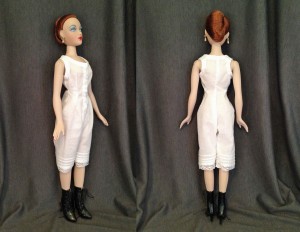
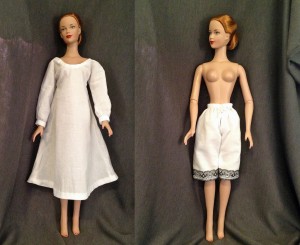
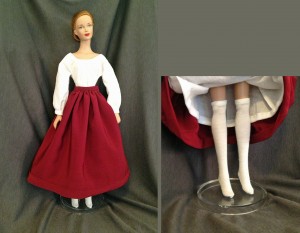
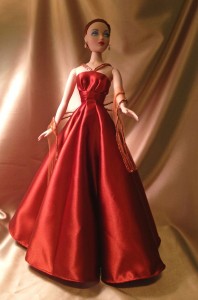
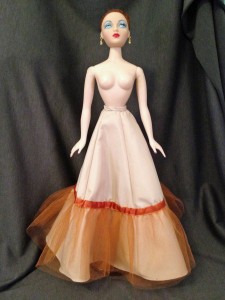
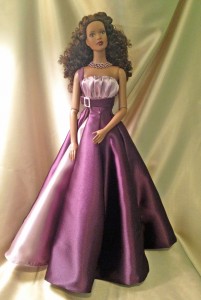
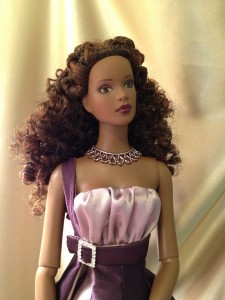
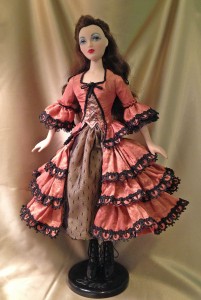
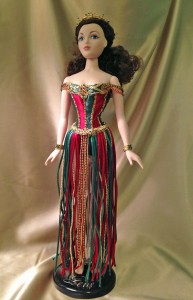
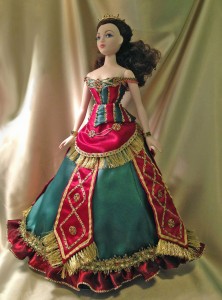

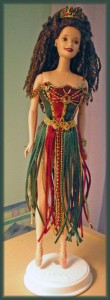
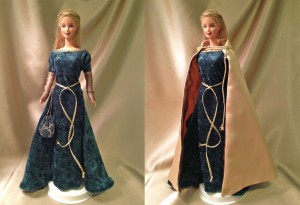
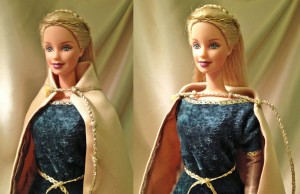
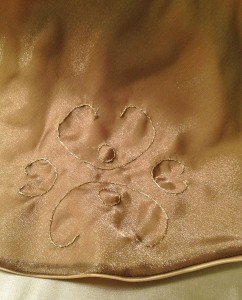
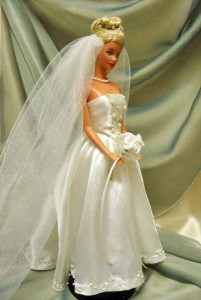
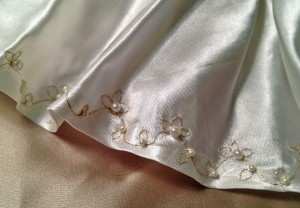
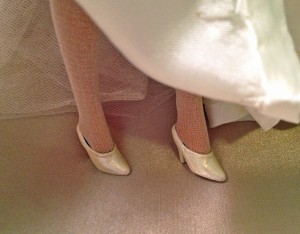
Pingback: Portfolio | Yesterday's Thimble
Pingback: Update: Doll Portfolio | Yesterday's Thimble
Your doll clothes make my heart purr. I love them. I started out sewing making doll clothes from my favorite aunt’s scrap fabric. I would sit at her feet with my needle and thread while she sewed on her machine. It’s one of my earliest memories and you brought some of them back for me. I admire your attention to detail so much.
Thanks for your comments, you’re very kind! My grandmother made me a couture wardrobe for my Barbie dolls when I was small, so I know the feeling of nostalgia. Without her example to follow, I probably wouldn’t be a doll costumer today.
Your comments about the fabrics that you used and things you found out along the way were very helpful to me as I set out to make a “custom” (really a pattern mashup) wedding dress for Tyler Wentworth. Additionally I have a couple new Gene dolls Id like to sew for; Gene and Tyler are new to me so it was a delight to read this page! Thanks so much for sharing!